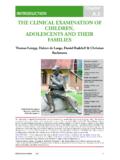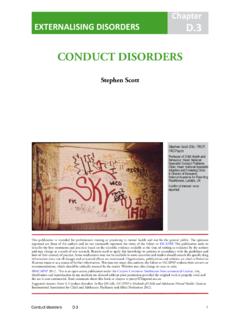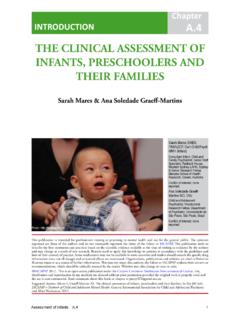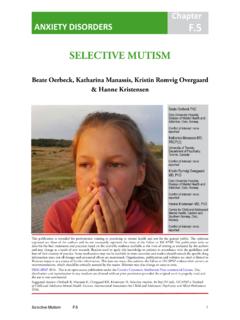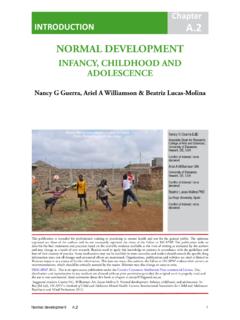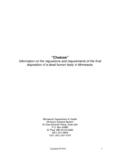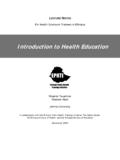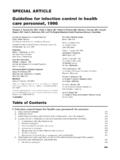Transcription of CPP Textbook o Child and dolescent ental Health …
1 Treatment planning Textbook of Child and Adolescent Mental NurcombeDIAGNOSIS AND TREATMENT PLANNING IN Child AND ADOLESCENT MENTAL Health PROBLEMSThis publication is intended for professionals training or practicing in mental Health and not for the general public. The opinions expressed are those of the authors and do not necessarily represent the views of the Editor or IACAPAP. This publication seeks to describe the best treatments and practices based on the scientific evidence available at the time of writing as evaluated by the authors and may change as a result of new research. Readers need to apply this knowledge to patients in accordance with the guidelines and laws of their country of practice. Some medications may not be available in some countries and readers should consult the specific drug information since not all dosages and unwanted effects are mentioned.
2 Organizations, publications and websites are cited or linked to illustrate issues or as a source of further information. This does not mean that authors, the Editor or IACAPAP endorse their content or recommendations, which should be critically assessed by the reader. Websites may also change or cease to exist. IACAPAP 2014. This is an open-access publication under the Creative Commons Attribution Non-commercial License. Use, distribution and reproduction in any medium are allowed without prior permission provided the original work is properly cited and the use is non-commercial. Suggested citation: Nurcombe B. Diagnosis and treatment planning in Child and adolescent mental Health problems. In Rey JM (ed), IACAPAP e- Textbook of Child and Adolescent Mental Health . Geneva: International Association for Child and Adolescent Psychiatry and Allied Professions Nurcombe MDEmeritus Professor of Child & Adolescent Psychiatry, the University of Queensland, Brisbane, AustraliaConflict of interest: none 8 students taking part in the pilot phase of the Respect4U intervention at a secondary school in Masiphumelele, Cape Town, South Africa (Photo: Julius Oatts) 2 Treatment planning Textbook of Child and Adolescent Mental HealthThe term diagnosis is derived from a Greek word meaning distinguishing, discernment, or deciding.
3 Diagnosis was used by Hippocrates to refer to the process of medical reasoning. Today, it is applied to both the process and the product of has a number of functions, it: Allows clinicians to describe cases from a common perspective Enables the collection of data for administrative purposes Can be used for scientific purposes such as to collect cases of a similar nature and to expose them to contrasting treatments Is the key to treatment chapter concerns the formulation of a diagnosis in such a manner as to facilitate individualized treatment mental disorder is a clinically significant pattern of psycho-behavioural symptoms and signs associated with current distress or impairment experienced by the patient or people in the environment or with the risk of future distress or impairment. The concept of disorder falls short of the scientific validity of disease.
4 Disorder and disease convey biological disadvantage (Scadding, 1967). Some of the disorders described in DSM-5 (American Psychiatric Association, 2013) or ICD-10 (World Health Organization, 1992) may be distinctive and categorical; however, most are likely to be dimensional, with diagnostic cut-off points that are determined arbitrarily or by statistical formulae. This is of particular importance when a number of behavioural disturbances coincide and it is debatable whether polymorphous dimensionality or categorical comorbidity apply. To the extent that it is dimensional, a disorder is likely to have been determined by a variable mix of genetic and temperamental factors with learned adaptive responses ( , conduct disorder), whereas a truly categorical disorder is likely to have a biological basis ( , Rett syndrome).
5 Not all disorders or syndromes will prove to predominantly be categorically distinct; and some that appear to be categorically distinct today will eventually turn out to be clinician combines the distinction of categorical prototypes with an eliciting of the dynamic factors involved in the genesis and perpetuation of the patient s condition. This chapter deals with the way a diagnostic formulation can be framed in such a manner as to assist treatment DIMENSIONS OF DIAGNOSISIt is useful to conceptualise diagnostic formulations in three axes or dimensions (see also Chapter ): Biopsychosocial Developmental and biopsychosocial dimensionAt any one time, a patient is composed of functions at biological (bottom), psychological and social (top) levels ( , molecular, cellular, and organ system Categories versus dimensionsA categorical diagnosis implies a clear, qualitative difference between having and not having a disorder ( , breast cancer) while a dimensional diagnosis implies a quantitative difference ( , hypertension).)
6 There has been much debate about the merits and shortcomings of either approach. In practice, a categorical approach to diagnosis is clinically more practicable ( , indicating need for treatment). Nevertheless, most recent classifications (such as DSM-5) try to incorporate both approaches, for example, by including ratings of severity in diagnoses or by defining a spectrum ( , autism spectrum disorders). For more details see Chapter was used by Hippocrates to refer to the process of medical reasoning. Today, it is applied to both the process and the product of decision-making. Do you have questions? Comments?Click here to go to the Textbook s Facebook page to share your views about the chapter with other readers, question the authors or editor and make planning Textbook of Child and Adolescent Mental Healthfunctioning; unconscious and conscious psychological functioning; and family-social adaptation).
7 Each level emerges from the level below. No level can be reduced to the level below, although science may seek to find associations between levels ( , between molecular synaptic dysfunction and psychosis).The physician analyzes the following levels in formulating diagnosis:1. Physical level Peripheral organ symptoms The immune system The autonomic nervous system The sensorimotor systems2. Psychological level Information processing (orientation, attention, memory, comprehension, judgement) Learning Communication Attitude to self and others Social competence Psychological symptoms Unconscious conflicts and ego defences3. Social level Family structure and dynamics Social relations School and occupational adjustmentThe developmental dimensionThe clinician evaluates the different systems within the biopsychosocial axis to determine whether any are abnormally delayed, advanced, or deviant in relation to what could be expected at the patient s age.
8 Autism, for example, is associated with delayed and deviant development ( , in communication, social relations, and verbal reasoning). The developmental dimension is most important in the evaluation of children and temporal dimensionA human life is like a film: it begins from somewhere, is seen as though in a freeze-frame, and is proceeding to a future. The temporal dimension requires an understanding of the following:Predisposition What are the physical, psychological or social influences genetic, intrauterine, perinatal and early developmental that predisposed the patient to 4 Treatment planning Textbook of Child and Adolescent Mental Healthbe psychologically disturbed at the time of examination. Were there any sources of stress, trauma, or deprivation in the formative years?PrecipitationIs there evidence for a physical or psychosocial stressor that coincided with the onset of the psychological disturbance and could have pushed the individual into disequilibrium?
9 Common stressors include physical illness ( , hepatitis causing depression), exposure to psychological trauma or loss, marital discord and separation. Some recent psychological stressors may be recapitulations of unresolved childhood traumata. Not all current problems are precipitated: some ( , autism) have gradually evolved from an earlier predisposing deviation or is useful to ask, why now? If a problem has been apparent for some time, why is the individual or the family presenting for help at this time. Has an additional stress caused failure in the previously compensated physical or psychosocial system?PatternThe pattern of biopsychosocial symptoms and signs constitutes the current disturbance (phenomena representing the disorder or disorders identified according to DSM or ICD).
10 Do the symptoms and signs represent a decompensation or impending decompensation of inadequate adaptation (with anxiety, somatization or the discharge of tension), the emergence of more primitive coping mechanisms ( , denial, repression, dissociation), the fragmentation of mental functioning (as in psychosis), or the residue of past decompensation (as in chronic conversion disorder)? Do the symptoms have an unconscious communicative or mimetic (imitative) function (as in some forms of conversion)? If so, what is being communicated and to whom? Are the symptoms predicated upon actual or imagined physical illness? If so, does the patient obtain secondary gain from the illness?PerpetuationMany psychological problems are short-lived; the precipitating stress dissipates or is coped with, sometimes with enhanced functioning.

